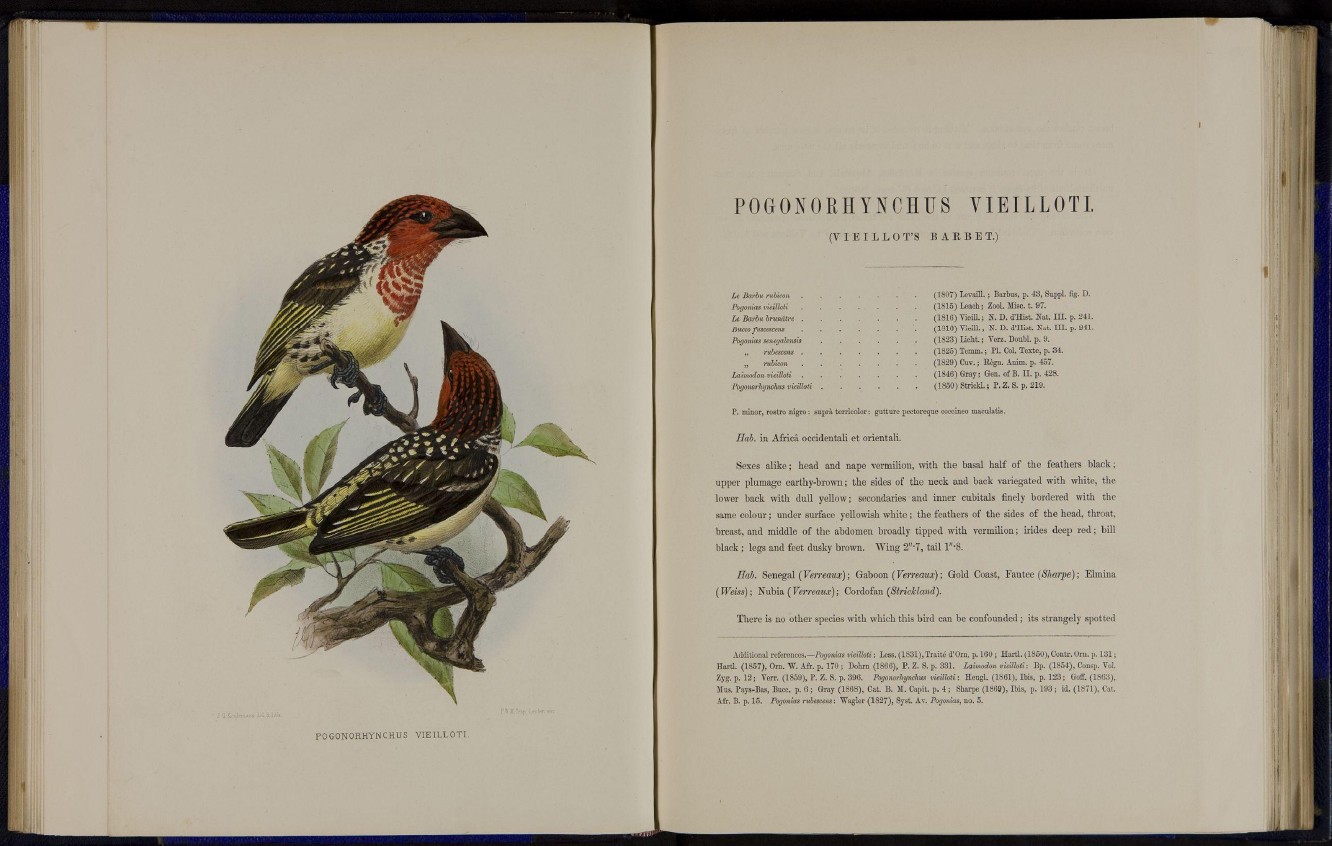
POGONORHYNCHUS V I E I L L O T!
(V I E I L L O T ' S B A R B E T .)
Le Barbu rubicon
Pogonias vieilloti
Le Barbu brunâtre
Bucco fuscescens
Pogonias i
„ rubicon
Laimodon vieilloti
Pogonorhynchus vieilloti
(1807) Levaill.; Barbus, p. 43, Suppl. fig. D.
(1815) Leach; Zool. Misc. t. 97.
(1816) Vieill.; N. D. d'Hist. Nat. III. p. 241.
(1816) Vieill.; N. D. d'Hist. Nat. III. p. 241.
(1823) Licht.; Verz. Doubl, p. 9.
(1825) Temrn.; PI. Col. Texte, p. 34.
(1829) Cuv.; Règn. Anim. p. 457.
(1846) Gray; Gen. of B. II. p. 428.
(1850) Strickl.; P. Z. S. p. 219.
P. minor, rostro nigro : supra terricolor : gutturc pectorequc coccineo maculatis.
Hab. in Africa occidentali et oriental!
Sexes alike; head and nape vermilion, with the basal half of the feathers black;
upper plumage earthy-brown; the sides of the neck and back variegated with white, the
lower back with dull yellow; secondaries and inner cubitals finely bordered with the
same colour; under surface yellowish w h i t e ; the feathers of the sides of the head, throat,
breast, and middle of the abdomen broadly tipped with vermilion; hides deep red; bill
black ; legs and feet dusky brown. Wing 2"*7, tail l"-8.
Hab. Senegal (Verreaux); Gaboon (Verreaux); Gold Coast, Fantee (Sharpe); Elmina
(Weiss); Nubia (Verreaux); Cordofan (Strickland).
There is no other species with which this bird can be confounded; its strangely spotted
Additional references.—Pogonias vieilloti : Less. (1831), Traité d'Orn. p. 160 ; Hartl. (1850), Contr. Urn. p. 131 ;
Hartl. (1857), Orn. W. Afr. p. 170 ; Dohrn (1866), P. Z. S. p. 331. Laimodon vieilloti: Bp. (1854), Consp. Vol.
Zyg. p. 1 2 ; Verr. (1859), P. Z. S. p. 396. Pogonorhynchus vieilloti: Heugl. (1861), Ibis, p. 123; Goff. (1S63),
Mus. Pays-Bas, Bucc. p. 6 ; Gray (1868), Cat. B. M. Capit. p. 4 ; Sharpe (1869), Ibis, p. 193 ; id. (1871), Cat.
Afr. B. p. 15. Pogonias rubescens : Wagler (1827), Syst. Av. Pogonias, no. 5.